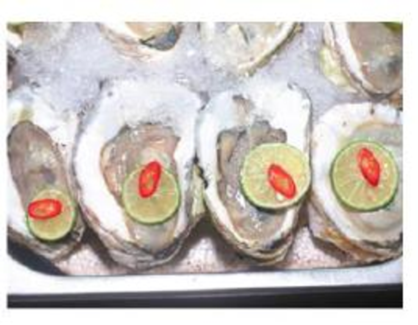
Raw Oysters and Antacids: A Deadly Mix?

The highly acidic environment of the stomach kills most bacteria before they cause disease. One bacterium that can slightly tolerate conditions as it passes through the stomach is Vibrio vulnificus—a bacterium commonly ingested by eating raw tainted oysters. The bacterium cannot be seen, tasted, or smelled in food or water.
V. vulnificus is an emerging pathogen and a growing cause of food poisoning in the United States: it triggers vomiting, diarrhea, and abdominal pain. The pathogen can also infect the bloodstream, causing life-threatening illness characterized by fever, chills, skin lesions, and deadly loss of blood pressure. About 50% of patients with bloodstream infections die. V. vulnificus especially affects the immunocompromised and people with long-term liver disease.
Researchers have discovered that taking antacids may make people more susceptible to becoming ill from V. vulnificus. They found that antacids in a simulated gastric environment significantly increased the survival rate of V. vulnificus.
- 1. Why are patients who take antacids at greater risk for infections with V vutnificus?
- 2. Will antacids raise or lower the pH of the stomach?
- 3. Other than refraining from antacids, what can people do to reduce their risk of infection?
Learn your wayIncludes step-by-step video

Chapter 2 Solutions
EBK MICROBIOLOGY:W/DISEASES BY BODY...-
Additional Science Textbook Solutions
Organic Chemistry (8th Edition)
Physics for Scientists and Engineers: A Strategic Approach, Vol. 1 (Chs 1-21) (4th Edition)
Anatomy & Physiology (6th Edition)
Microbiology: An Introduction
Applications and Investigations in Earth Science (9th Edition)
Campbell Biology (11th Edition)
- How is a protein destined for the Endoplasmic Reticulum (ER), imported into the ER? Be concise.arrow_forwardFind out about the organisations and the movements aimed at the conservation of our natural resources. Eg Chipko movement and Greenpeace. Make a project report on such an organisation.arrow_forwardWhat are biofertilizers and mention the significancearrow_forward
- PCBs and River Otters: Otters in Washington State’s Green-Duwamish River have high levels of polychlorinated biphenyls (PCBs) in their livers. PCBs can bind to the estrogen receptors in animals and disrupt the endocrine system of these otters. The PCBs seem to increase the estrogen to androgen ratio, skewing the ratio toward too much estrogen. How would increased estrogen affect the river otter population? Based on your reading of the materials in this unit, what factors can affect fertility in humans? Explain how each of the factors affecting human fertility that you described can disrupt the human endocrine system to affect reproduction.arrow_forwardOther than oil and alcohol, are there other liquids you could compare to water (that are liquid at room temperature)? How is water unique compared to these other liquids? What follow-up experiment would you like to do, and how would you relate it to your life?arrow_forwardSelection of Traits What adaptations do scavengers have for locating and feeding on prey? What adaptations do predators have for capturing and consuming prey?arrow_forward
- Competition Between Species What natural processes limit populations from growing too large? What are some resources organisms can compete over in their natural habitat?arrow_forwardSpecies Interactions Explain how predators, prey and scavengers interact. Explain whether predators and scavengers are necessary or beneficial for an ecosystem.arrow_forwardmagine that you are conducting research on fruit type and seed dispersal. You submitted a paper to a peer-reviewed journal that addresses the factors that impact fruit type and seed dispersal mechanisms in plants of Central America. The editor of the journal communicates that your paper may be published if you make ‘minor revisions’ to the document. Describe two characteristics that you would expect in seeds that are dispersed by the wind. Contrast this with what you would expect for seeds that are gathered, buried or eaten by animals, and explain why they are different. (Editor’s note: Providing this information in your discussion will help readers to consider the significance of the research).arrow_forward
 Human Heredity: Principles and Issues (MindTap Co...BiologyISBN:9781305251052Author:Michael CummingsPublisher:Cengage Learning
Human Heredity: Principles and Issues (MindTap Co...BiologyISBN:9781305251052Author:Michael CummingsPublisher:Cengage Learning





